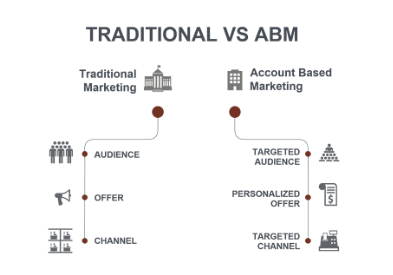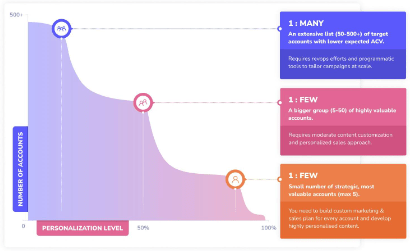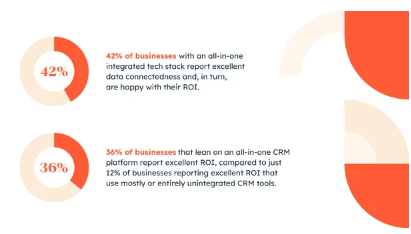If you are new to account-based marketing or seeking to optimize existing ABM efforts, delving into the topic can help attain a deeper understanding and ABM’s potential impact on B2B marketing. Also, explore additional resources on ABM to acquire valuable insights, real-world case studies, and the latest best practices.
B2B marketers consistently seek dynamic marketing approaches to grow their organizations' business. They must employ effective inbound marketing strategies to promote their reach. One such B2B marketing strategy is account-based marketing.
Account-Based Marketing (ABM) is a powerful B2B strategy to target high-value accounts. However, challenges such as non-personalized content can limit its effectiveness. Marketers can overcome these challenges by scaling personalization efforts, improving team communication, enhancing data quality, & embracing new channels & metrics. It involves several marketing techniques that can enhance the overall process to generate more prospects and leads for all types of businesses.
By focusing on individual high-value accounts, ABM allows businesses to forge meaningful connections and drive exceptional results. According to the statistics, 97% of marketers agree that ABM leads to higher ROI than other marketing strategies.
But like any marketing strategy, account-based marketing is not without challenges. Reports indicate that very few marketers have mature ABM marketing strategies, and most of them are yet to find ways to implement ABM.
This blog will explore the seven most common challenges in executing ABM and present practical solutions to overcome them. But let’s first understand what ABM is and why it is vital for business success.
Hire a digital marketing agency to assist with your marketing strategy.
What is Account-Based Marketing (ABM)?
Account-based marketing (ABM) emphasizes identifying and engaging with high-value accounts, and this approach is employed to develop personalized marketing campaigns that cater to each account’s needs. Such a targeted practice proves highly effective in attracting new customers and nurturing and expanding relationships with existing ones.
Marketers can implement ABM in several ways, but it typically involves the following steps:
- Identify the target accounts
- Research the target accounts
- Create personalized marketing campaigns
- Track and measure the results
Implementing ABM requires collaboration between marketing and sales teams to identify, assess, and analyze high-value accounts and create a personal touchpoint by delivering personalized content, messages, and offers.
Why is ABM Important?
ABM is a highly effective marketing strategy for B2B companies because it allows them to focus their resources on the accounts that are most likely to generate revenue. Here are some key benefits of ABM:
- Unparalleled Precision: 87% of professionals agree that customers expect at least some personalized content. ABM allows marketers to strategically develop content based on customer requirements and their stage in the buyer's journey.
- Significant Increase in Revenue: According to a study, 60% of companies see at least a 10% increase in revenue in the first year when using ABM.
- Marketing and Sales Alignment: ABM fosters collaboration between marketing and sales departments, maximizing overall success.
- Improved Customer Experience: ABM creates personalized touchpoints that resonate with customers, enhancing satisfaction and retention.
- Understanding of Goal Conversion: ABM provides a clear understanding of ROI with lower investments and a transparent sales funnel. It empowers businesses to analyze and measure goal conversion effectively, leading to more informed decision-making and improved outcomes.
Though account-based marketing holds enormous potential, marketers might experience some challenges. The top challenges of ABM include delivering personalized experiences, understanding & picking target accounts, and creating a content utilization process.
B2B marketing teams must comprehend the challenges they could face while launching an ABM campaign.
Top 7 Challenges in Account-Based Marketing and How to Overcome Them
While account-based marketing results are undeniable, many marketers feel navigating ABM is complicated due to the complex systems and inexperience. But these hurdles are resolvable with in-depth understanding, the right tools, and expertise.
- Lack of Personalized and Differentiating Content
- Insufficient Data and Insights
- Misalignment of Sales and Marketing Teams
- Set and Leverage the Right Metrics
- Disconnected Tech Stack
- Scaling ABM Across Organizations
- Determining the Success of ABM Efforts
Lack of Personalized and Differentiating Content
One of the significant principles of ABM is personalization, so the first step of ABM includes building a target account list (TAL) and creating content that will connect with TAL on a deeper level.
While it is crucial to put the audience first, creating tailored content for each account takes time, resources, & intensive approach. It is more burdensome when dealing with ample datasets.
Solutions
- Develop a content framework: This helps in focusing on different stages of the buyer's journey, allowing marketers to work along a structure for content creation and ensure consistency across multiple accounts.
- Leverage automation tools: Automation tools are omnipresent, and by using dynamic content and personalization tools, marketers can weave messages based on account-specific data, such as industry or pain points.
Insufficient Data and Insights
ABM extensively relies on accurate and comprehensive data to identify target accounts, understand buyer personas, and personalize marketing campaigns. Most organizations miss up to 80% of their total target audience, and up to 50% of B2B companies have outdated data. The lack of quality data can impede the success of ABM.
Solutions
- Investing in data enrichment strategies: Implement strategies to refine existing data using third-party sources or data enrichment tools to remove the data gaps. Investing in data enrichment helps marketers with real-time and updated information for target accounts and reduces wasting resources on unqualified leads.
- Maintain data hygiene: Marketers should make data hygiene their top priority. Otherwise, it is nearly impossible for B2B companies to take advantage of ABM tools and achieve their ABM goals.
- Leverage marketing automation platforms: Marketing automation tools help drive success and replicability. Marketing automation simplifies identifying, understanding, prioritizing, and targeting appropriate audiences without errors and common mistakes.
Misalignment of Sales and Marketing Teams
Another significant challenge to execute account-based marketing is the alignment gap between sales and marketing teams. It happens when there is poor communication, untethered goals, and a lack of accountability among sales and marketing teams. All these inefficiencies can hamper the efficacy of ABM endeavors.
Solutions
- Encourage open communication channels: Sales and marketing teams collaborate well when they often engage via periodic meetings to align goals, discuss strategies, and convey insights. Professionals from both teams can use tools to promote real-time communication and enhance transparency.
- Outline shared ABM objectives: With precise and measurable ABM goals, both teams can work together harmoniously. Outlining a shared purpose will help the teams collaboration and have a common objective to execute ABM.
- Implement a closed-loop feedback system: Create a feedback loop where sales and marketing teams can provide insights, shortening the sales cycle. When both teams communicate effectively, deals will close swiftly.
Set and Leverage the Right Metrics
Many marketers report that changing their perspective from traditional metrics is significantly challenging for teams. Traditional marketing heavily relies on tracking metrics like page views, impressions, or traffic, which are not suitable KPIs for ABM.
The sales team must also cease to think about marketing-qualified leads (MQLs), and instead should focus on marketing-qualified accounts (MQAs) as a key metric for account-based marketing.
Solutions
- Determine key performance indicators (KPIs): Set precise and quantifiable suitable KPIs that align with the ABM goals. It could include metrics like deal size, customer lifetime value, account engagement, and customer retention.
- Implement multi-touch attribution models: Marketers should focus on attribution models considering multiple touchpoints across the buyer's journey to provide a more granular and personal-level perspective than traditional methods such as media mix modeling.
- Align sales and marketing reporting: It is essential for the sales and marketing teams to align their analysis and reporting mechanisms and should percept a common understanding of success rate. Also, ensure periodically reviewing and analyzing data to identify trends and areas for improvement.
Disconnected Tech Stack
A disconnected tech stack refers to the inability to integrate and align marketing and sales, resulting in decentralized data and a disjointed customer experience. It hampers creating a holistic view of the customer data, making it difficult to engage target accounts.
Besides, studies show that 42% of businesses with an all-in-one integrated tech stack led to excellent data integration and increased ROI.
Solutions
- Adopt Account-Based Experience (ABX) approach: ABX is about engaging buyers with relevant messages via trusted traditional marketing channels using insights.
- Align process and technology: To eliminate disconnection, B2B businesses can employ a single technology platform to seamlessly integrate with CRM, marketing platform, and web personalization tools to offer a 360° view of significant activities.
- Simplify and standardize workflows: Take measures to identify and eliminate silos by including data integration and standardizing formats to facilitate smooth workflows and to reduce manual handoffs by using automation tools.
Scaling ABM Across Organizations
As already mentioned, ABM is an effective but time-consuming strategy. Hence, scaling ABM can be challenging, especially during the pilot program to full-scale implementation transition. Besides, scaling ABM initiatives requires careful planning and execution.
Solutions
- Communication ABM value: Marketers should ensure that all the relevant departments understand how crucial it is to implement ABM and how it suits the organization’s overall objectives.
- Implement tiered segmentation of accounts: Go beyond the standard Ideal Customer Profile (ICP) and segment the accounts into tiers by comparing their life time value (LTV) so as to focus on top-tier accounts for better outcomes.
- Employ technical tools and automation: Technology helps to scale ABM and expand reach with limited resources, hence, automation tools like AI-powered chatbots, and predictive analytics can assist B2B teams to expedite the scaling process and improve efficiency.
Determining the Success of ABM Efforts
Companies often need help to identify indicators that reflect ABM strategy success due to the lack of a universal set of metrics to gauge its effectiveness. The personalized approach used for ABM makes calculating ROIs complex, as it requires tracking individual account interactions and attributing revenue to specific campaigns.
Moreover, it requires cross-functional teams with different objectives adding to the challenge.
Solutions:
- Focus on tangible metrics suited for ABM: Shift the focus from vanity metrics (page views, clicks, etc.) to meaningful indicators like MQLs, account penetration, pipeline growth, target account engagement, and revenue generation.
- Two-framework measurement: The KPIs should focus more on engagement levels than traffic volume. Develop a two-framework measurement structure that involves considering activity-based metrics.
- Consider using technology: Several platforms offer different reports depending on the KPIs selected to measure the ABM performance. Hence, before building the MarTech stack, consider the reporting capabilities for better alignment.
Addressing Account-Based Marketing Challenges
Embracing account-based marketing (ABM) presents endless opportunities for B2B businesses to propel revenue growth and foster lasting relationships with target accounts. According to MarketingProfs, companies using ABM have witnessed a remarkable 208% increase in revenue.
Delivering highly personalized content to high-value accounts for this process is a challenging and straining process for B2B businesses. However, marketers can overcome these with suitable ABM techniques. Here is the rundown of tips to help tackle the top ABM challenges.
- Develop a solid framework to personalize content to create customized experiences that resonate with target accounts.
- Align sales and marketing teams through regular communication and shared goals.
- Enhance data quality to understand target accounts better and tailor messaging and offers accordingly.
- Segment, optimize and explore new platforms to cater to changing requirements.
- Determine relevant KPIs and implement multi-touch attribution models for improved efforts.
- Scale ABM efforts by identifying ICPs and segment target accounts.
- Embrace ABX and streamline sales and marketing technologies to avoid disconnected tech stacks.
With a strategic and collaborative approach, organizations can reap the rewards of a well-executed ABM strategy and achieve remarkable results.
Additional Reading:


